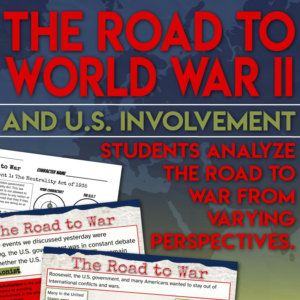Description
Students will learn first about Japanese Internment, and then about how propaganda expanded to film and photographs and became more subtle in WWII. They will examine photos from the War Relocation Authority first and then the photos created by Dorothea Lange (and others) that showed the actual experience of internment.
The contrast between propaganda and reality really helps students to understand the subtleness of propaganda and how it can influence opinion. There is a short paragraph that students write at the end of the lesson that has them articulate the contrast.
Topics Include: Japanese Internment | Propaganda | Korematsu v. the United States
Included in this resource:
- 4 page handout (Google Slides, PDF, and PowerPoint)
- A PowerPoint and Google Slides Version of the slideshow (classroom and digital versions)
- 23 image Gallery Walk (Google Slides, PDF, and PowerPoint)
- A lesson plan with guidance for implementation
This lesson addresses the following NYS Social Studies Standards:
8.6b.4 – Students will examine the internment of Japanese Americans in light of perceived national security concerns versus constitutional rights, including the decision in Korematsu v. United States (1944).
© COPYRIGHT 2024 PEACEFIELD HISTORY. ALL RIGHTS RESERVED.
Permission is granted to copy pages specifically designed for student or teacher use by the original purchaser or licensee. This is intended to be used by one teacher unless additional licenses have been purchased. The reproduction of any other part of this product is strictly prohibited. Copying any part of this product and placing it on the Internet in any form besides Google Classroom is strictly forbidden. Doing so makes it possible for an Internet search to make the document available on the Internet, free of charge, and is a violation of the Digital Millennium Copyright Act (DMCA).









Reviews
There are no reviews yet.